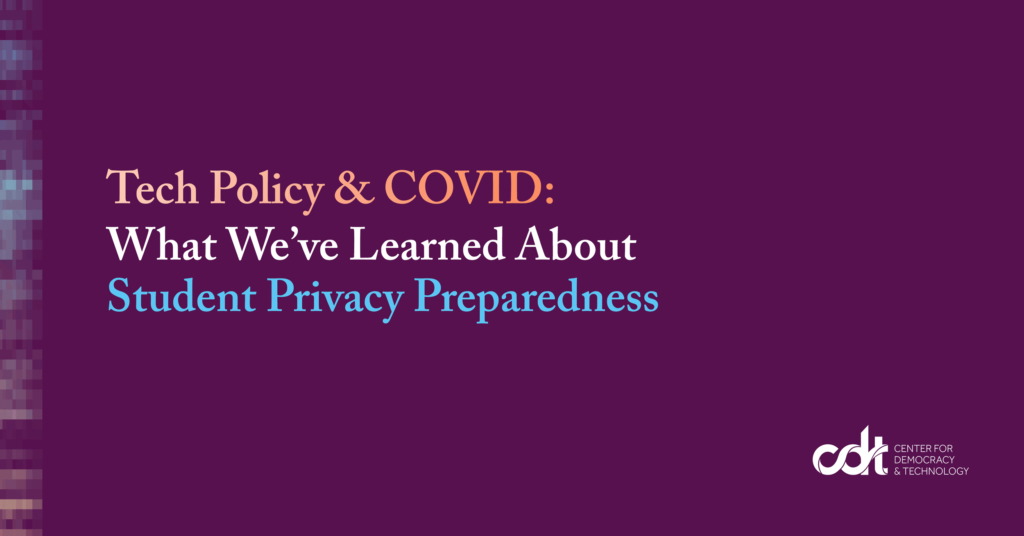Equity in Civic Technology, Privacy & Data
Tech Policy & COVID: What We’ve Learned About Student Privacy Preparedness

CDT’s new survey research shows schools are making progress on privacy protection, but more work is needed to keep students safe.
For nearly every school in the country, this March marks the one-year anniversary of the abrupt transition to online learning and the beginning of a dogged struggle to support students in the face of COVID-19. Technology and data have played a vital role in facilitating this major educational transition, as schools sought to roll out new digital platforms to host instruction and equip students with the devices and connectivity they needed to access them. Concurrent with this increase in technology reliance came an increase in privacy and security risks and equity issues. Numerous headline-grabbing student privacy breaches and technological failures have demonstrated why education technology (edtech) implementation must be accompanied by policies and practices that protect the students these tools are meant to serve.
Today, CDT released new research based on teacher and parent polling conducted in February 2021. These updated findings explore how the views and actions of teachers, parents, and schools have changed since last summer, and provide insight into privacy preparedness going forward. We found that schools are making progress on thoughtful technology implementation, privacy protection, and teacher support, but more work is needed to keep students safe. Education leaders should take five key actions to balance the benefits of data and technology with privacy, security, and equity risks:
- Continue to establish and update privacy-forward policies
- Better equip teachers to use technology responsibly
- Address the latest privacy and security risks that pose the greatest threats to students
- Engage parents in privacy protection
- Embed privacy protection in efforts to close the homework gap
To explain why we are recommending these actions, it is important to reflect on where the education system was at the beginning of the pandemic and the changes that have occurred over the past year related to data, technology, and privacy.
EdTech and Student Privacy at the Beginning of COVID-19
Last summer, CDT sought to better understand the views of those who have the most at stake in edtech and student privacy issues: parents, teachers, and students themselves. Based on our polling research, we found that teachers and parents strongly supported edtech use — but nevertheless, there were serious gaps in privacy awareness and school policies to ensure students’ safety online. Sadly, these shortcomings have been borne out in the privacy failures of the past year, which featured the proliferation of invasive tracking software, record rates of school cybersecurity attacks, and adoption of data-driven decision-making tools that harm marginalized student populations. Through these instances, schools and districts have had to learn the hard way about the importance of privacy protection, and students have paid the price.
EdTech Support and Positive Privacy Trends
Our latest findings demonstrate the value of edtech tools in the past year. Significant majorities of teachers and parents describe education technology as “very important” for remote schooling as a result of COVID-19. Perhaps more surprising is the strong support for ongoing classroom edtech use, even after students return to campus — 85 percent of teachers and 74 percent of parents express that they are likely to support online learning as part of their children’s classroom instruction once campuses re-open.
Are schools learning the lessons of the past year’s privacy pitfalls? Our latest research suggests that yes, they are — slowly. Teachers report modest growth in several key metrics related to privacy preparedness, including teacher familiarity with student privacy procedures, teacher training on student privacy protection, school guidance on technology use during COVID-19, and schools’ likelihood to have a tech plan in place that addresses privacy and security. Importantly, many of these metrics are driven by school administrative decisions, which indicates that districts and other education institutions are structurally adapting to the new reality.
These findings highlight that increased edtech use is here to stay. Over the course of the pandemic, technology use has helped many schools reimagine how they can better serve their students. Although the education context will change as the pandemic subsides, educators are anticipating how to translate the benefits of online learning into their post-pandemic practices. In light of this, it is critical that student privacy protection keeps pace in order to keep students safe in the learning environments of the future.
Technology and Privacy Preparedness Gaps Remain
These areas of growth suggest a promising trend, but changes are not being implemented quickly enough. Teacher and parent levels of concern about student privacy remain unchanged since last summer (four-in-ten and six-in-ten report concern, respectively), and 37 percent of teachers still report receiving no substantive training on privacy policies and procedures, despite growth in training from last school year to this school year.
A closer dive into the specifics of teacher privacy preparedness suggests much larger gaps: 77 percent of teachers do not report receiving training on best practices for mitigating risks associated with videoconferencing, and 75 percent of teachers do not report receiving training on phishing or ransomware protection. Those gaps are concerning given that these have been two of the most prominent vectors of recent security failures.
Looking Forward
As schools, educators, and families prepare for the next phase of the pandemic, they should heed the lessons from the past year’s experiences with student privacy. The first step is to recognize that increased edtech use will continue post-pandemic, and educators should plan accordingly to prepare for the associated privacy and security risks. Schools should seek to build on the trends of improved privacy protection by implementing responsive guidance and proactively communicating with their staff. Parents also play an important role in privacy protection going forward — they have expressed privacy concerns and growing interest in engaging with their schools on these issues. With thoughtful planning and communication, schools can engage teachers and parents to better protect student privacy going forward.


